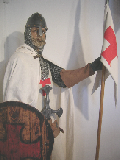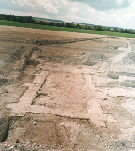
















Hugh of Payns had given a part of his land to the Temple. He had given up his lordship, given his castle to his elder son, persuaded his wife Elizabeth to renounce the world and given a part of his land to create a commanderie.
As with all the institutions of this type, the commanderie of Payns was a big farm with a chapel. It looked like a barn in many respects but its main function was to produce the means to support the Templar army which was fighting in the Far East. The buildings of the commanderie took up three hectares in the middle of a vast 200 hectare territory on the Payns’s land.
In September 1998, an archaeological dig took place on the site of Hugh of Payns’s domain. The systematic excavation of the whole site wasn’t accepted despite the essential importance of the domain of Payns for the study of the Order of the Temple regarding the history of the Middle Ages.
The archaeologist decided on a superficial excavation of the chapel to determine the plan. Then the week of the excavation consisted of very carefully excavating the whole foundations of the chapel.
Now we know that the chapel of the commanderie of Payns was of “cella” type.- rectangular like the ones of Avalleur and Fresnoy. It had three trenches and it was 20.6 meter long and 9 m wide with chalk walls on both chalk and flint foundations – about 1.4 meter thick.
If we compare the plans of these three chapels, we can see striking resemblances which confirm the theory that the Templars didn’t have any particular architectural features but used to have their chapels built according to the custom and the tastes of the time and by project managers who worked both for them and the Clergy.
The foundations study shows stone excesses on the North side of the chapel which leads us to think that a huge building was next to it according to the width of the walls - nearly 3 m wide. There was a graveyard around the chapel..

We would be able to rebuild the interior of the chapel thanks to decorative and architectural items found in the mounds of earth formed by the excavation of the chapel which one could compare to other buildings in the region. The pieces of small columns must come from a door, and the pieces of glass and lead testify to the existence of stained-glass windows.
We discovered a sculpted item, part of a three-part arch which may have been upon a swimming pool. On the other hand, as it was the custom at that time, the walls of the chapel of the commanderie of Payns were covered with frescoes. Indeed, pieces of wall paintings have been discovered. They represent ochred false joint sceneries highlighted in brown evoking a fictitious equipment. Such sobriety is in line with the ideal of poverty shared by the Templars and the Cistercians.
The last aspect of the chapel we can talk about concerns the starting point of our discoveries : the multicoloured paving. It is composed of 20 cm and 4 cm thick square glazed tiles. (all the colours are represented) This type of typical XII century glazed tiles had already been found in Cistercians institutions but what is interesting in the discovery is the fact we have found these tiles for the time in their right place.
These discoveries made in Payns enable us to have an idea of what a Templar chapel looked like. We can now easily understand the importance of a real archaeological excavation led on the whole site of the commanderie. Other trenches have enabled us to detect the presence of annexes which are not clearly identified but could be barns or stables as well as a small portion of the surrounding wall.
It seems that the buildings of the commanderie fell in ruins from the XV century, maybe during the Hundred Years War. Today, only important archaeological relics remain and they should be protected. Now, the historians and archaeologist have left behind the commanderie of Payns – certainly the first of the Templar commanderie as it was founded by the first master of the Templars on his own land. The fantastic discoveries made after the archaeological probing haven’t been exploited. The regional archaeological department has closed the matter because of the lack of money and motivation. Thus, the Occidental birthplace of the Order of the Temple seems to have been abandoned. Though it would provide a privileged field of exploration to the specialists who would be inclined to study the subject : the archaeological relics of the most important Templar site which have been preserved from the action of time since the suppression of the Order.
©Thierry Leroy
(Translater: L. Coutelas)
Payns's templars commanderie